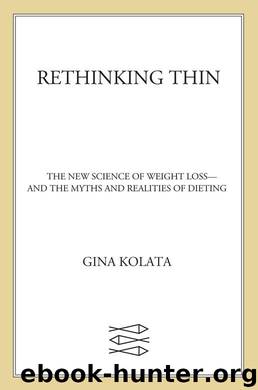Rethinking Thin: The New Science of Weight Loss--and the Myths and Realities of Dieting by Kolata Gina

Author:Kolata, Gina [Kolata, Gina]
Language: eng
Format: epub
Publisher: Farrar, Straus and Giroux
Published: 2008-04-29T00:00:00+00:00
6
Insatiable, Voracious Appetites
So what does make you want to eat? What makes you unable to stop? If nothing else, the annals of medicine reveal that at least for some people, at least in some circumstances, something is going on in the brain that compels them to eat. And whatever that drive is, it can be impossible to consciously control. Wanting to eat less works for only so long. Eventually that drive, powerful as the urge to drink water or even the drive to breathe, takes over.
That was a hard-earned lesson for research scientists, though, and it only emerged after a century of science and a slow, painful, tortuous path of discoveries that began long before the studies with people who agreed to starve themselves or to try to gain weight and that continued for more than a century. It went on haltingly and with great difficulty while scientists like Mickey Stunkard studied twins and adoptees and while one diet guru after another promoted what were claimed to be failure-proof ways to lose weight.
The gradual unraveling of the brain circuits that control eating began with the story of a fat little boy, and came to include rats that were so voracious they ate themselves to death, and mice so grotesquely obese that although they could barely move, they could not stop stuffing themselves with food. It was the work that would finally uncover the secret pathways deep inside the brain that determine how much food is eaten and how much food is enough. And unless those brain circuits were found, researchers knew, dieters would be left forever with that old and not terribly useful advice that dates back to Hippocrates: To control your weight, simply eat less and exercise more.
The story begins at a time when there were almost no tools to probe the human brain. It was the dawn of the twentieth century when a young boy walked into the office of an Austrian physician, Alfred Froehlich. The first thing you would notice about the boy, referred to in case histories as R.D., was that he was fat.
The child was born in 1887 and was slim until March 1899, when he suddenly began gaining weight. Two years later, when R.D. was fourteen, his despairing parents took him to see Froehlich. The doctor performed a detailed physical exam and, questioning the boy, learned that obesity was just one of his problems. The boy’s genitals had not developed, the vision in his left eye was failing, and he complained of excruciating headaches, saying it hurt when Froehlich tapped on his skull. All those symptoms added up to a pituitary tumor, Froehlich reasoned. That meant that the boy’s best hope was an operation to remove the growth in that gland in the base of his brain.
Froehlich saw the tumor, a white-sheathed glistening orb, as soon as he opened R.D.’s skull. It was just where he thought it would be. “In the depth of the sphenoid sinus, the whitish membrane of a cyst the size of a hazelnut was encountered.
Download
This site does not store any files on its server. We only index and link to content provided by other sites. Please contact the content providers to delete copyright contents if any and email us, we'll remove relevant links or contents immediately.
How to Be a Bawse: A Guide to Conquering Life by Lilly Singh(6721)
Deep Work by Cal Newport(5537)
The Longevity Diet by Valter Longo(4463)
The Fat Loss Plan by Joe Wicks(4257)
The Four-Pack Revolution by Chael Sonnen & Ryan Parsons(3494)
The Ultimate Bodybuilding Cookbook by Kendall Lou Schmidt(3347)
The French Women Don't Get Fat Cookbook by Mireille Guiliano(2996)
Super Food Family Classics by Jamie Oliver(2922)
Turn Up Your Fat Burn! by Alyssa Shaffer(2822)
Factfulness_Ten Reasons We're Wrong About the World_and Why Things Are Better Than You Think by Hans Rosling(2764)
Not a Diet Book by James Smith(2754)
Tom Kerridge's Dopamine Diet: My low-carb, stay-happy way to lose weight by Kerridge Tom(2687)
Body Love by Kelly LeVeque(2638)
Self-Esteem by Matthew McKay & Patrick Fanning(2614)
The Unbecoming of Mara Dyer by Michelle Hodkin(2495)
Tone Your Tummy Type by Denise Austin(2374)
The Fat Chance Cookbook by Robert H. Lustig(2328)
LL Cool J's Platinum 360 Diet and Lifestyle by LL Cool J(2320)
Men's Health Best by Men's Health Magazine(2104)
